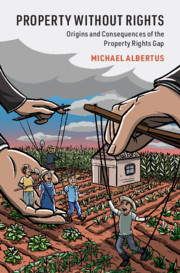Book contents
- Property without Rights
- Cambridge Studies in Comparative Politics
- Property without Rights
- Copyright page
- Contents
- Figures
- Tables
- Acknowledgments
- 1 Introduction
- 2 Conceptualizing and Measuring the Property Rights Gap
- 3 The Political Origins of the Property Rights Gap
- 4 Evidence on the Rise and Fall of Property Rights Gaps in Latin America
- 5 Consequences of the Property Rights Gap
- 6 Opening and Closing a Property Rights Gap in Peru
- 7 The Long-Term Consequences of Peru’s Property Rights Gap
- 8 Property Rights Gaps around the World
- 9 Conclusion
- Book part
- References
- Index
- Other Books in the Series (continued from page iii)
2 - Conceptualizing and Measuring the Property Rights Gap
Published online by Cambridge University Press: 22 December 2020
- Property without Rights
- Cambridge Studies in Comparative Politics
- Property without Rights
- Copyright page
- Contents
- Figures
- Tables
- Acknowledgments
- 1 Introduction
- 2 Conceptualizing and Measuring the Property Rights Gap
- 3 The Political Origins of the Property Rights Gap
- 4 Evidence on the Rise and Fall of Property Rights Gaps in Latin America
- 5 Consequences of the Property Rights Gap
- 6 Opening and Closing a Property Rights Gap in Peru
- 7 The Long-Term Consequences of Peru’s Property Rights Gap
- 8 Property Rights Gaps around the World
- 9 Conclusion
- Book part
- References
- Index
- Other Books in the Series (continued from page iii)
Summary
This chapter conceptualizes, codes, and provides a visualization of property rights gaps. Land can be held by individuals, groups, and governments; ownership can be formalized or informal in various ways; and property rights can face a diverse array of restrictions. I home in on several critical components of property rights in constructing my property rights gap measures: land formalization, defensibility, and alienability. I use these aspects of property rights to construct measures of complete, partial, and absent property rights. Based on these definitions, this chapter outlines the original data, I collected on land reform and property rights through land titling in Latin America, and then visualizes the data used to construct measures of the property rights gap. The chapter situates the data and patterns relative to important forms of landholding such as collective and communal land rights, cooperatives, land that is nationalized, and individually held land. This chapter also discusses the evolution of land rights in Latin America from the colonial period to the early 1900s.
Keywords
Information
- Type
- Chapter
- Information
- Property without RightsOrigins and Consequences of the Property Rights Gap, pp. 32 - 70Publisher: Cambridge University PressPrint publication year: 2021
